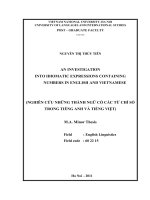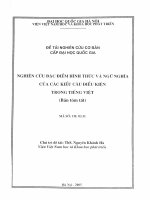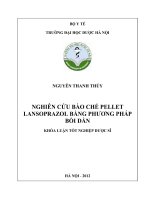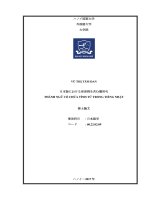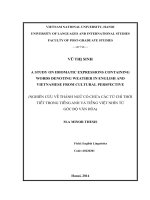Nghiên cứu về thành ngữ có chứa các từ chỉ thời tiết trong tiếng anh và tiếng việt nhìn từ góc độc văn hóa
Bạn đang xem bản rút gọn của tài liệu. Xem và tải ngay bản đầy đủ của tài liệu tại đây (380.19 KB, 71 trang )
!"
# $
%& !#'
$
(
)"
*)
+
,
,
(
-*-
.-
/01.
2%.
3+.
4.
5'"(*0!(6"'(0*("5$7589*0#!
--52
---52
--.*:
-.-;
-.--;
-.."
-./+( -/
-.2-4
-.35-<
-/=.;
5'"(*"=06(!9$%'! ("!+(%(0+%50!"!!9
=0*%(!0"!9=("'(*
.-%(== ==
..%(== ==.4
5'"(*"'*((6!!9%!%5#%%0!
/-% (
//
/.5(== ==
/3
//5(== ==
/:
-*2/
.22
/%23
*((*(!5(%24
(!>
!
!(
(
"
('
?A study on idiomatic expressions containing
words denoting weather in English and Vietnamese from cultural perspective@
(
A(==B
A ==B+
(
0
"
(
(== ==
C
"#$%!#&'(
"6
&((
-
&
& + (
)*!+,!#
"16
& (
&5
&%
"C6
&=(
D
&=(
D
-+.!$%!#&'(
"(
"
7
/!%'#$%!#&'(
CC
(
"))
(
0!#1$%!#&'(
"6
&"
.
&.5
?%!2!+ )+312&'@
5?1 #%
'!"!#!'"#+142'#'!14!%!25
(
"?'1#'
'#+&##@(==
==
&/5
"
/
66
$'
(
A(==B
A ==B"
)
& &2!'%!2! #%.)!4!! 1&1!'+& &2!
& &2!'#"!+%2+!2#+#$+& &2!
"?@
+
'
6
'A-<E; &./B?
@
F
%GA.;;/B6
?"
1C
@A%G
.;;/EB
2
%("7
?5@A-E:-B?
C@A-B
?$569@*
A.;;3B
?HF
HF@A/.B+
"
8A-<<EB
?0!
A$ nascere6B,
A$ colere6B5
A8-<<E62B
9A-<3:B
?F
@A9-<3:6-4:B
%1?
@A''.;;;6B
0"A-<<26./B
%+A.;;:B6?5&
11
3
@
''A.;;;B
?"HF
@AB"
5
A'-<:4-4B
5
*)
'A-<<4B?"
@
%+A.;;:6 &/;B
6
F
$
"
7
"
FF
%"
ABA
BAB
4
"
=
1?
I1
@A'=+7-;;36/EB
5?
@1A.<B"
F
'
"
'?
@A.;;36/<B
5
"
! #%.)!4!! 1&1!'+& &2!
:
"
0
7FA%+.;;:6-42B6
?$ %
$=
,
,
&&@
%+A.;;:B?
@ A-4EB "
%&%?",
@A%&
%.;;/6.EB
8A-<<EB
'
6
7F
language expresses cultural reality
+
" &&
"
"& language embodies
cultural reality.
E
%,
"
1"
language symbolizes cultural reality.
8A.;;;B?$
=
@A/B"
)$A.;;3B?
@A.3B
% + A.;;:B
)6
?J
@A%+6.;;:-:/B
( A.;;:B
=
!
5C
95
$
<
7A-<<2B?
@A
-43B '
'"#
!$
(
&
6
?5507#$@A.;;.B
?6
HFH)F@AB
?
(6?@?
@
(6?
@
@A.;;.6B
+A-<<:B?
@
-;
?5@A-<<4B?@
I
?
@"
!
?$ @ 0
?@
%'A-<<3B0
$F?
@
'6?an idiom is a fixed phrase
whose meaning cannot be exposed by looking at the meaning of its individual
words”.
1)I
(.!#$'"#
)"
5
A-<<46B36
&+?+F@?
@
&%?"F@IF
AB
&%?$@I1
&?
@& )
&%$(?
@
$A-<:<B6
&"6
1
?%@?'@I'
?@
C0
11
('the salt of the earth A'
CB
&"
"
?@
K
&61?@
?@+
"?@?@A
B
&?@6it
"
5?AB@IC
& 6
((?=@
&%6,?
@A
B
&"6
,
F
&%6C
,ABA
B
$!&2!#$'"#1 #%'!"!#!
%
(== ==
!"+$!&2!#
A-<::B?
@
C"
'
-/
?"F
@?
@
'
"?@
" ?5LMNO@A
B?5PL@A
QB0
=
"?5RSTL@A
B?UVS@AB
?0@AB?
@AB
%?&
@A
B?"@A
B%?F@AFB
?"@AB
?"@
?@AB?
@AB
2&+&2 $!&2!#
?%@
-2
?%@
)$F
?"F@?'
) @ A
B,?'
)@
%"1
6?$@AB?@A
B?'@AB?0@ABJ
"C?9
@AB
""
'
11
&6
A dead duck (a subject or idea that is no longer important, interesting or valued):
C
F
&6
Get wind of something (to hear a piece of information that someone else was trying
to keep secret): '
&1
Safe and sound (safe and unharmed)6
&
Night and day (all the time without stopping)6
-3
&
On cloud nine (extremely happy)6
&16
Never say die! (never give up hope)
Well, I never! (used to express surprise or disbelief)
-'"#,!2#&#.2,!2)#'# 1
*)
"
-'"#,!2#&#.2,!2)#
"
(?8
@?@@
)
?@
A5
+-<:3B
-4
A$?@B
0 $F
A.;;4B?&
@?F
@?=@ !A.;;;B
?
1@A/<B% ?+WXY
Z@?5[S\[[@?]^\@
"
"
1!
?&@
9
+
F
7
7
%
1
"1
?+@
-:
1
"?C
@
=
A?=
@B1
A?@?@JB
-'"#,!2#&## 1
% 0 $F “very informal
words, phrases, etc., commonly used in speech, especially between people from the
same social group or who work together, not considered suitable for formal
contexts and often not in use for long”. %
)
&
"?@
AB?__@A&B
5?
@==?)@-<2;-<:;?@
-<E;?@
-E
?@ ' ?@ ?@
75C
)
/& &2!'"
8A-<44B
6
Kaplan’s Graphic representations of thoughts processes of linguistic groups
(1966:21)
"(
AB0AB
'
$
,
C5C
-<
!%!2'!$
"
1
"
!
1
?"'
(@6
?&&
%
"
?@
@A-<<26E<2B
?0 @ A-<<3B
?
@
7F
"
"
"
)"
(== ==
.;
&""2(
I

